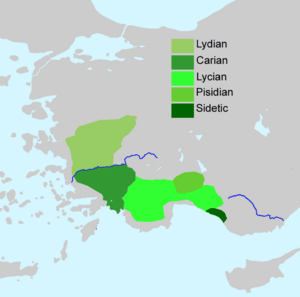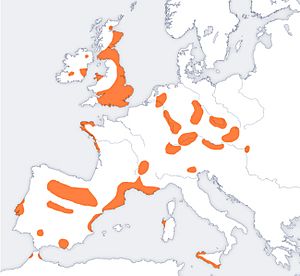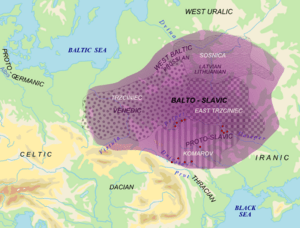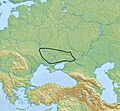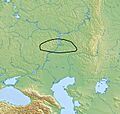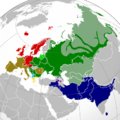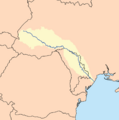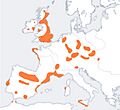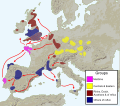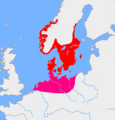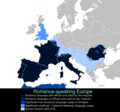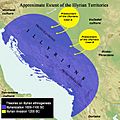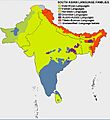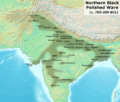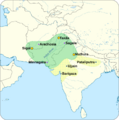Indo-European migrations facts for kids
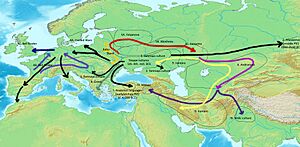
– Center: Steppe cultures
1 (black): Anatolian languages (archaic PIE)
2 (black): Afanasievo culture (early PIE)
3 (black): Yamnaya culture expansion (Pontic-Caspian steppe, Danube Valley) (late PIE)
4A (black): Western Corded Ware
4B-C (blue & dark blue): Bell Beaker; adopted by Indo-European speakers
5A-B (red): Eastern Corded ware
5C (red): Sintashta (proto-Indo-Iranian)
6 (magenta): Andronovo
7A (purple): Indo-Aryans (Mittani)
7B (purple): Indo-Aryans (India)
[NN] (dark yellow): proto-Balto-Slavic
8 (grey): Greek
9 (yellow): Iranians
– [not drawn]: Armenian, expanding from Catacomb culture into the South Caucasus
The Indo-European migrations are believed to be how languages like English, Spanish, Hindi, and many others spread across a huge area of Europe and Asia. These movements happened roughly between 4000 and 1000 BCE. People speaking early forms of these languages moved from one place to another.
We can't directly study prehistoric languages, but experts use clues from different fields. Linguistics helps by comparing languages to see how they are related. Archaeology looks at old tools, homes, and burial sites to track where people lived. Genetics studies ancient DNA to understand how different groups are connected. All these clues together help us understand how the "Proto-Indo-European" language (PIE) and its daughter languages spread.
A popular idea, called the Kurgan hypothesis, suggests that the earliest Indo-European speakers lived in the Volga basin. From there, different groups moved out. For example, the Anatolian languages (like Hittite) were an early branch. Later, the Tocharian languages spread to what is now western China. Most other Indo-European languages came from a later group, the Yamnaya people, who lived in the Pontic-Caspian steppe around 3000 BCE.
Understanding the Migrations
Language Clues
Many languages in Europe and Asia share similarities. This suggests they came from a common ancestor language. Scholars like Sir William Jones noticed these links between languages like Sanskrit (from India), Ancient Greek, and Latin. This led to the idea of the Indo-European language family.
Today, there are hundreds of Indo-European languages and dialects. They are spoken by nearly 3 billion people. This makes it the largest language family in the world. Many major languages, including English, Spanish, Hindi, and Russian, belong to this group.
Proto-Indo-European Language
The Proto-Indo-European language (PIE) is like the "grandparent" language of many modern languages. Experts have "reconstructed" it, meaning they've figured out what it might have been like. They believe PIE was spoken around 3500 BCE.
The most accepted idea for where PIE started is the Kurgan hypothesis. This places its origin in the Pontic–Caspian steppe in Eastern Europe. PIE was a complex language with many word changes to show meaning, similar to how "sing, sang, sung" changes.
Archaeological Discoveries

Archaeologists have found many ancient cultures that help us understand these migrations. The Kurgan hypothesis suggests that the Indo-European language and culture spread from the Pontic steppes. This happened through people moving and also by powerful groups influencing others.
This process began around 5200 BCE when cattle were introduced to the steppes. Later, the invention of wheeled wagons and horse riding made people much more mobile. This led to a new way of life for herders. Between 4500 and 2500 BCE, cultures like the Yamnaya culture spread across the steppes and into Europe and Asia.
Early migrations around 4200 BCE brought steppe herders into the lower Danube valley. The Anatolian languages, like Hittite, likely arrived in Anatolia from this region. Migrations eastward led to the Afanasevo culture, which is linked to the Tocharian languages.
The Yamnaya culture is connected to the later stages of PIE. Its origins are thought to be in the Don-Volga area around 3400 BCE.
How Languages Spread
Languages can spread in different ways. Sometimes, large groups of people move and bring their language with them. Other times, smaller, powerful groups might introduce their language, and local people start using it to gain status. This is called "elite recruitment."
When Indo-Europeans moved into Europe, they met people who spoke different languages. Over time, the Indo-European languages replaced many of these older languages. However, some words from the original languages, especially those related to farming, remained.
For example, about 30% of modern German words might come from an older, non-Indo-European language spoken by people in Scandinavia. When Indo-European speakers met these local groups, they became dominant. But some of the local words became part of Proto-Germanic.
DNA Studies
Since the 2000s, genetic studies have become very important. They show how different ancient groups are related. Studies have found that about 75% of the DNA of people from the Corded Ware culture came from Yamnaya-related groups. This supports the idea of large migrations.
Climate Changes
Climate changes might have played a big role in these migrations. Around 4200-4100 BCE, Europe experienced colder winters. This might have pushed steppe herders into new areas.
Later, between 3500 and 3000 BCE, the steppes became drier and cooler. Herds needed to move more often to find food. Wagons and horse riding made this possible, leading to a more mobile way of life for the Yamnaya people.
In the second millennium BCE, widespread dry conditions led to water shortages in Asia. This caused the collapse of cities and triggered large migrations.
Where Did It All Begin?
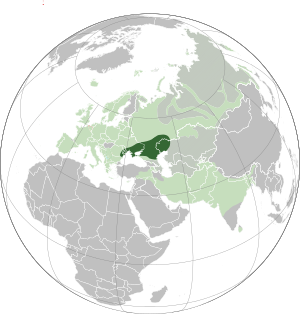

The question of the "original homeland" (Urheimat) of the Proto-Indo-European language is a big puzzle. Experts try to match language history with archaeological finds.
The Kurgan Hypothesis
Since the 1980s, most experts agree with the Kurgan hypothesis, or the "revised Steppe hypothesis." This idea places the Indo-European homeland in the Pontic steppe of Eastern Europe, between the Dniepr and Ural rivers. This area is a vast grassland north of the Black Sea and Caspian Sea.
This region is where horses were first tamed. This allowed early Indo-Europeans to travel widely and influence or conquer other cultures. The term "Kurgan" comes from a Russian word for a burial mound. The Kurgan culture includes the Yamnaya people and related groups.
Marija Gimbutas first developed the Kurgan hypothesis in the 1950s. She grouped several related cultures on the Pontic steppes. Later, David Anthony refined this, focusing on the Yamnaya culture (3300–2500 BCE) as the main source of Indo-European spread. Recent DNA studies support the idea of Yamnaya people migrating into Western Europe.
Other Ideas
There are other theories about the Indo-European homeland:
- Anatolian Hypothesis: Proposed by Colin Renfrew, this idea suggests that Indo-European languages spread peacefully from Anatolia (modern Turkey) around 7000 BCE. This would have happened with the spread of farming. However, this idea is generally not accepted today because it doesn't fit with recent DNA evidence.
- Armenian Hypothesis: This theory suggests the homeland was south of the Caucasus Mountains, in what is now Armenia. Some recent genetic research has brought this idea back into discussion.
Early Indo-European Groups
Anatolian Languages (Hittites)

The Anatolian languages were an early branch of the Indo-European family. The most famous speakers were the Hittites, who built a large empire in the Middle East around 2000-1200 BCE. Their language was discovered in ancient texts, which was a big surprise to historians.
It's thought that the Anatolian languages split off very early from the main Proto-Indo-European group. They likely arrived in Anatolia from the north, possibly through the Balkans or the Caucasus. Their arrival was probably a gradual settlement, not a sudden invasion. The Hittites were known for their use of chariots and for being early developers of iron tools.
Tocharian Languages

The Tocharian languages were spoken in ancient oasis cities in the Tarim Basin (modern China). They are known from manuscripts from the 6th to 8th centuries CE. These languages were later replaced by Turkic languages.
The Tocharians are thought to have come from the Afanasevo culture in Siberia (about 3500–2500 BCE). The famous Tarim mummies, dating from 1800 BCE, were once thought to be Tocharian speakers. However, recent DNA studies suggest they were local people. The studies now suggest that Tocharian languages were introduced to the region by Afanasievo migrants.
The eastward spread of Indo-Europeans brought new ideas to Chinese culture, like wheeled vehicles and domesticated horses.
Later Indo-European Expansions
Yamnaya Culture and Its Spread

The Yamnaya culture (3300–2500 BCE) is very important for understanding the spread of most Indo-European languages. It started in the Don-Volga area. The Yamnaya people were mobile herders who used wagons and rode horses. This allowed them to move quickly across the steppes.
This culture also brought new social rules. It represents the classic Proto-Indo-European society, with stone idols and a focus on raising animals. Between 3100 and 2600 BCE, Yamnaya people spread into the Danube Valley in Europe. This migration likely led to the development of Proto-Celtic and Pre-Italic languages.
Impact in Europe
Between about 4000 and 3000 BCE, the number of people in Western Europe declined. This was possibly due to diseases. After this, Indo-European speaking groups migrated into Western Europe. This changed the genetic makeup of the populations there. DNA studies show that a large part of the ancestry of modern Europeans came from these steppe herders.
Corded Ware Culture
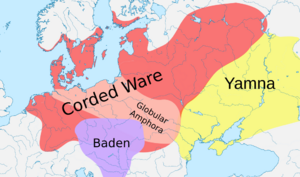
The Corded Ware culture (about 3200–2450 BCE) in Central Europe played a key role in spreading Indo-European languages. It is thought to have originated north-east of the Carpathian mountains. It then spread across northern Europe.
DNA evidence shows that people of the Corded Ware culture were genetically very similar to the Yamnaya people. This suggests a large migration from the Eurasian steppes to Central Europe. The Corded Ware culture may have introduced Germanic, Baltic, and Slavic languages to northern Europe.
Bell Beaker Culture
The Bell Beaker culture (about 2900–1800 BCE) might be linked to the ancestors of Celtic languages. These people moved westward from the Alpine regions. They were known for their distinctive bell-shaped pottery. Their early movements were often by sea, spreading along the coasts of Spain, France, and into Italy.
Germanic Languages
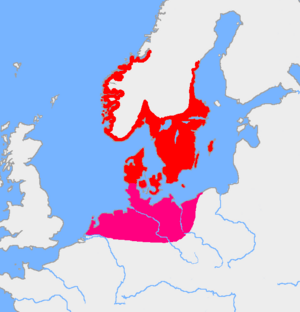
The Germanic peoples, who speak languages like English, German, and Swedish, came from Northern Europe. Their ancestral language, Proto-Germanic, was likely spoken in Denmark and northern Germany around 1800 BCE. About 28% of Germanic words are not from Indo-European origins, suggesting they mixed with local languages.
By the 3rd century BCE, Germanic peoples expanded south, meeting Celts and Illyrians. Later, during the Migration Period and Viking Age, Germanic groups moved across Europe, even reaching North America.
Italic and Celtic Languages
The Italic (like Latin, which led to Spanish, French, Italian) and Celtic (like Irish, Welsh) languages are often grouped together. This suggests they might have a common ancestor or developed close to each other.
Proto-Latins might have come from eastern Hungary, influenced by the Yamnaya culture. The Italic languages spread into Italy later. Today, Romance languages (from Latin) are spoken by over 800 million people worldwide.
The earliest Celtic culture is thought to be the Late Bronze Age Urnfield culture in Central Europe (around 1200 BCE). Later, the Hallstatt culture and La Tène culture spread Celtic influence across Europe, including the British Isles. Today, modern Celtic languages are mostly spoken in the northwestern edge of Europe, like Ireland and Wales.
Balto-Slavic Languages
The Balto-Slavic group includes Baltic languages (like Lithuanian and Latvian) and Slavic languages (like Russian, Polish, Czech). These languages share many features, suggesting a common development period.
The Balts lived in an area from the Baltic Sea to near Moscow. The Slavs spread across Central, Eastern, and Southeast Europe from the early 6th century CE. Today, over half of Europe's territory is inhabited by Slavic-speaking communities.
Balkan Languages
Languages like Thracian, Dacian, Illyrian, and Albanian were spoken in the Balkans. Thracian and Dacian were related and spoken in Southeast Europe. Their origins are unclear, but they likely developed from a mix of local people and Indo-Europeans during the Bronze Age.
Albanian is an Indo-European language spoken by about 7.4 million people, mainly in Albania and Kosovo. It's the only surviving language from the ancient Balkan languages.
Armenian, Greek, and Phrygian
Armenian was first written down around 406 AD. There are different ideas about how Armenian speakers arrived in Armenia. Some believe they came with the Phrygians from the west. Others think the language was already spoken there.
Greek is another branch of the Indo-European family. Proto-Greeks are thought to have migrated from northeast of the Black Sea to the Balkans and into Greece around 3200 BCE.
Phrygian was an ancient Indo-European language spoken in Asia Minor (modern Turkey). Some linguists think it was closely related to Greek. The Phrygians established a kingdom with its capital at Gordium.
Indo-Iranian Migrations
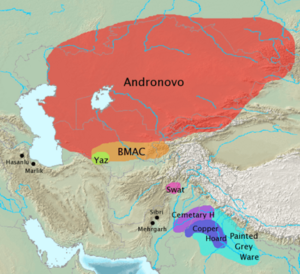
Indo-Iranian peoples include groups like Indo-Aryans (from India) and Iranians. They speak Indo-Iranian languages, a major branch of the Indo-European family.
The Proto-Indo-Iranians are often linked to the Sintashta culture and later the Andronovo culture in the Eurasian steppe. They also interacted with the Bactria–Margiana Archaeological Complex (BMAC), a non-Indo-European culture. This interaction influenced their language and religious beliefs.
The Indo-Iranian migrations happened in two main waves.
Indo-Aryan Migrations
The first wave involved Indo-Aryan migrations. They split from the Iranians around 1800–1600 BCE. One group, the Mitanni, founded a kingdom in northern Syria (about 1500–1300 BCE). Although the Mitanni spoke a non-Indo-European language, their rulers and some words show Indo-Aryan influence. This suggests a powerful Indo-Aryan elite.
The other group of Indo-Aryans, the Vedic people, moved over the Hindu Kush mountains into northern India. This was a slow spread during the Late Harappan period, starting around 1500 BCE. They established the Vedic religion, which later became a key part of Hinduism.
Iranian Migrations
The second wave was the Iranian migration, starting from 800 BCE. The Medes, Parthians, and Persians appeared on the western Iranian plateau. Their empires spread Iranian languages and culture across a vast area, from the Caucasus to the Indus River.
The Scythians were another Iranian group who dominated the Black Sea region. Later, Sarmatian tribes followed them into Europe. In Central Asia, Turkic languages later replaced many Iranian languages. In Eastern Europe, Slavic and Germanic peoples absorbed the local Iranian languages.
Images for kids
-
A map showing the approximate present-day distribution of the Indo-European branches within their homelands of Europe and Asia. The following legend is given in the chronological order of the earliest surviving written attestations of each branch:
-
The Hittite Empire at its greatest extent under Suppiluliuma I (about 1350–1322 BCE) and Mursili II (about 1321–1295 BCE)
-
Bronze Age spread of Yamnaya Steppe pastoralist ancestry into two subcontinents—Europe and South Asia, and location of the Afanasievo culture, which has the same genetic characteristics as the Yamnayas.
-
Wusun and their neighbours during the late 2nd century BCE, take note that the Yancai did not change their name to Alans until the 1st century.
-
Approximate extent of the Yuezhi Empire, as described in the History of Civilizations of Central Asia by UNESCO
-
Course of the Danube, marked in red
-
Map of the pre-Roman Iron Age in Northern Europe showing cultures associated with Proto-Germanic, about 500 BC. The area of the preceding Nordic Bronze Age in Scandinavia is shown in red; magenta areas towards the south represent the Jastorf culture of the North German Plain.
-
The early East Germanic expansion (1st and 2nd centuries AD): Jastorf culture (blue), Oksywie culture (red), Przeworsk culture (yellow/orange); eastward expansion of the Wielbark culture (light-red/orange).
-
Dacia during the reign of Burebista
-
Map of Dacia, 1st century BCE
-
Map of the approximate maximal extent of the Andronovo culture. The formative Sintashta-Petrovka culture is shown in darker red. The location of the earliest spoke-wheeled chariot finds is indicated in purple. Adjacent and overlapping cultures (Afanasevo culture, Srubna culture, BMAC) are shown in green.
-
Language families in the Indian subcontinent
-
Kingdoms, tribes and theological schools of the Late Vedic Period
-
Mahajanapadas (c. 500 BCE)



